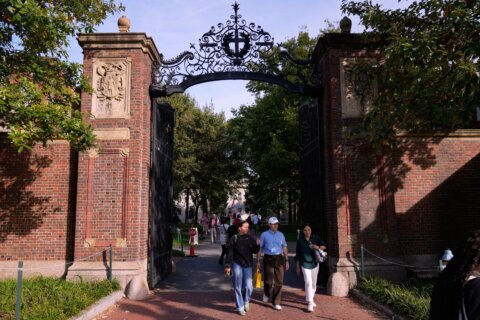Higher education can be a vast and confusing landscape, populated with thousands of colleges and universities across the nation, divided into many categories and comprising differing institutional missions.
When making a decision on where to enroll, prospective students and families are faced with a multitude of questions about how to pay for college, including how much debt they will take on, and how their chosen major will pay off, while also weighing factors such as academics, location, campus culture, safety and more.
To help demystify higher education and to aid students and their families in making the right college choice for them, U.S. News has released its 2021 Best Colleges rankings. The first edition of the rankings was released in 1983, and they have continued to evolve with more schools and data points for college-bound students to consider.
The 2021 edition provides data on more than 1,800 colleges and universities, with rankings for more than 1,400 institutions. Schools reported most of the data used to compile these rankings to U.S. News in an annual survey and were instructed to confirm the accuracy of their data. The rankings data pertains to student and faculty cohorts that predate the coronavirus pandemic, and thus the impact of COVID-19 on higher education is not reflected in how schools performed overall.
But to account for the sea change in higher education, U.S. News is now ranking test-blind schools, institutions that do not factor the SAT or ACT into admissions decisions, adding more than 60 colleges and universities to the rankings. Not to be confused with test-optional or test-flexible schools, which have long been and are still ranked, test-blind colleges had been excluded from the rankings since the 2008 edition. These colleges now appear in the rankings in their respective categories.
Readers will find schools in categories such as National Universities, institutions that are often research-oriented and offer bachelor’s, master’s and doctoral degrees; and National Liberal Arts Colleges, which emphasize undergraduate education and award half or more of their degrees across liberal arts fields. Additionally, regional colleges and universities are split into eight categories dependent on geographic location and whether master’s degrees are offered.
[See: Explore the 2021 Best National Universities.]
U.S. News uses 17 metrics to assess academic quality, with the greatest emphasis on outcomes, particularly a college’s ability to retain and graduate students. Other factors include class size, undergraduate academic reputation, and how much colleges spend on instruction and other educational investments.
Graduate indebtedness is a new metric added to the rankings this year to address families’ concerns about college affordability and the value of a degree; this factor takes into account the average amount of federal loan debt among graduating classes in 2019 at the bachelor’s level, as well as the proportion of grads who took out federal student loans. To make room for these new measures, U.S. News has reduced the weight given to SAT/ACT scores, high school class standing and alumni giving rates.
How Colleges Performed in the 2021 Rankings
Little changed at the very top of the National Universities rankings this year, with Princeton University in New Jersey once again ranked at No. 1, Harvard University in Massachusetts at No. 2 and Columbia University in New York at No. 3. Massachusetts Institute of Technology and Yale University in Connecticut are tied at No. 4, down from a three-way tie at No. 3 last year.
Rounding out the rest of the top 10 are Stanford University in California and the University of Chicago tied at No. 6, followed by the University of Pennsylvania at No. 8, and then a three-way tie with California Institute of Technology, Johns Hopkins University in Maryland and Northwestern University in Illinois all ranked in the No. 9 spot.
Most National Universities in the top 50 remained relatively steady with none moving dramatically up or down. Of schools in the top 50, the University of Miami saw the biggest jump, moving up from a tie at No. 57 to a tie at No. 49, while Northeastern University in Massachusetts had the biggest drop, falling from a tie at No. 40 to tie at No. 49.
Looking below the top 50, some colleges shot up in the 2021 rankings while others tumbled. Gallaudet University in Washington, D.C., for example, jumped up 55 spots from a tie at No. 179 to tie at No. 124 in this year’s rankings, and CUNY–City College in New York, tied at No. 228 last year, climbed 52 spots to a tie at No. 176.
Examples of colleges slipping significantly in this new edition of the rankings include Daemen College in New York, which dropped from a tie at No. 263 to the bottom quarter of the rankings, and Immaculata University in Pennsylvania, which moved down 30 spots from a tie at No. 211 to a tie at No. 241.
Schools atop the rankings of National Liberal Arts Colleges also held mostly steady with only minor fluctuations. Williams College in Massachusetts remains No. 1, followed again by Amherst College in Massachusetts at No. 2 and Swarthmore College in Pennsylvania at No. 3.
[Explore: See the 2021 Best Liberal Arts Colleges.]
The rest of the top 10 is comprised of Pomona College in California and Wellesley College in Massachusetts tied at No. 4; Bowdoin College in Maine, Claremont McKenna College in California and the United Stated Naval Academy in Maryland tied at No. 6; and Carleton College in Minnesota, Hamilton College in New York, Middlebury College in Vermont and Washington and Lee University in Virginia all tied at No. 9. Of those schools, the U.S. Naval Academy and Hamilton College each cracked the top 10 for the first time in Best Colleges history, with the former moving up 11 spots and the latter moving up five.
Notable shifts farther down the list in the National Liberal Arts Colleges category include Central College in Iowa jumping 20 spots from a tie at No. 160 to a tie at No. 140, and two colleges dropping 19 spots: The College of the Atlantic in Maine moved down from a tie at No. 82 to No. 101, and Marlboro College in Vermont slipped from a tie at No. 136 to a tie at No. 155.
Rankings mostly held steady among the top Regional Universities, which are schools that offer bachelor’s degrees, some master’s programs and limited options at the doctoral level. In the North, Bentley University in Massachusetts moved up one spot from No. 2 last year to a tie at No. 1 with Providence College in Rhode Island. Rollins College in Florida retained the No. 1 spot in the South, as did Butler University in Indiana in the Midwest. Likewise, Trinity University in Texas remained No. 1 in the West.
Looking at Regional Colleges, schools that focus on undergraduate education but award fewer than half of their degrees in liberal arts fields, the new No. 1 in the North is the United States Coast Guard Academy in Connecticut. High Point University in North Carolina retained the top spot in the South, while Cottey College in Missouri is the new No. 1 in the Midwest. Carroll College in Montana remained atop the list for Regional Colleges in the West.
Additional College Rankings to Consider
In addition to geographic location and institutional type, U.S. News ranks colleges in other categories, such as Top Public Schools.
These are colleges and universities operated and partially funded by state governments, and which research indicates are finding favor with prospective students amid the pandemic, as evidenced by an increase in those opting to attend in-state public institutions. The top three schools among National Universities in this year’s rankings remain the same, with the University of California–Los Angeles at No. 1, the University of California–Berkeley at No. 2 and the University of Michigan–Ann Arbor at No. 3.
[Read: How to Use the Best Colleges Rankings Wisely.]
Another category ranked by U.S. News is Best Value Schools, which considers a college’s academic quality alongside the net cost of attendance for a student who received the average level of need-based financial aid. A new factor in these rankings this year is the percentage of need-based aid recipients who received grants and scholarships. This change rewards colleges whose aid policies allow students to rely less on loans.
For Best Values among National Universities, Harvard claimed the top spot, offering need-based grants to 52% of undergraduate students for an average cost of $14,898 after disbursement of this aid, according to U.S. News data. Last year’s No. 1, Princeton, follows in the No 2 spot. Gallaudet rounds out the top three, jumping to third place from a Best Value Schools rank of No. 18 last year, and in turn bumping Yale down from No. 3 to No. 4.
Other categories ranked by U.S. News include the Best Colleges for Veterans, which are schools that award federal financial aid benefits specific to veterans and active service members, and enrolled a critical mass of these students; the Top Performers on Social Mobility, which are colleges that enrolled and graduated large proportions of economically disadvantaged students who were awarded Pell Grants; and, for the first time, the Best Undergraduate Computer Science Programs, which are undergraduate computer science schools and departments that deans and senior faculty at peer programs rated highly.
Additionally, U.S. News offers also offers tools to search and compare colleges and explore a vast range of data available on school profile pages, including detailed information on tuition, application fees and deadlines, popular majors and financial aid. College-bound students and their families can also compare postgraduate salary data collected by PayScale, which is displayed on many U.S. News school profile pages.
New this year, for readers who create free accounts on the U.S. News website, is a College Admissions Calculator, which allows users to compare their high school GPA and college entrance exam scores to other applicants who reported their admissions status at various schools.
Looking for full rankings information? Access the U.S. News College Compass to find all published data points, including student debt and employment statistics.
More from U.S. News
A Complete Guide to the College Application Process
How the Coronavirus Is Pushing Colleges to Go Test-Optional
10 Steps to Choosing the Right College
Princeton, Williams Top 2021 U.S. News Best Colleges Rankings originally appeared on usnews.com







